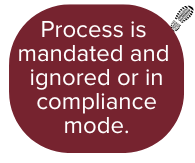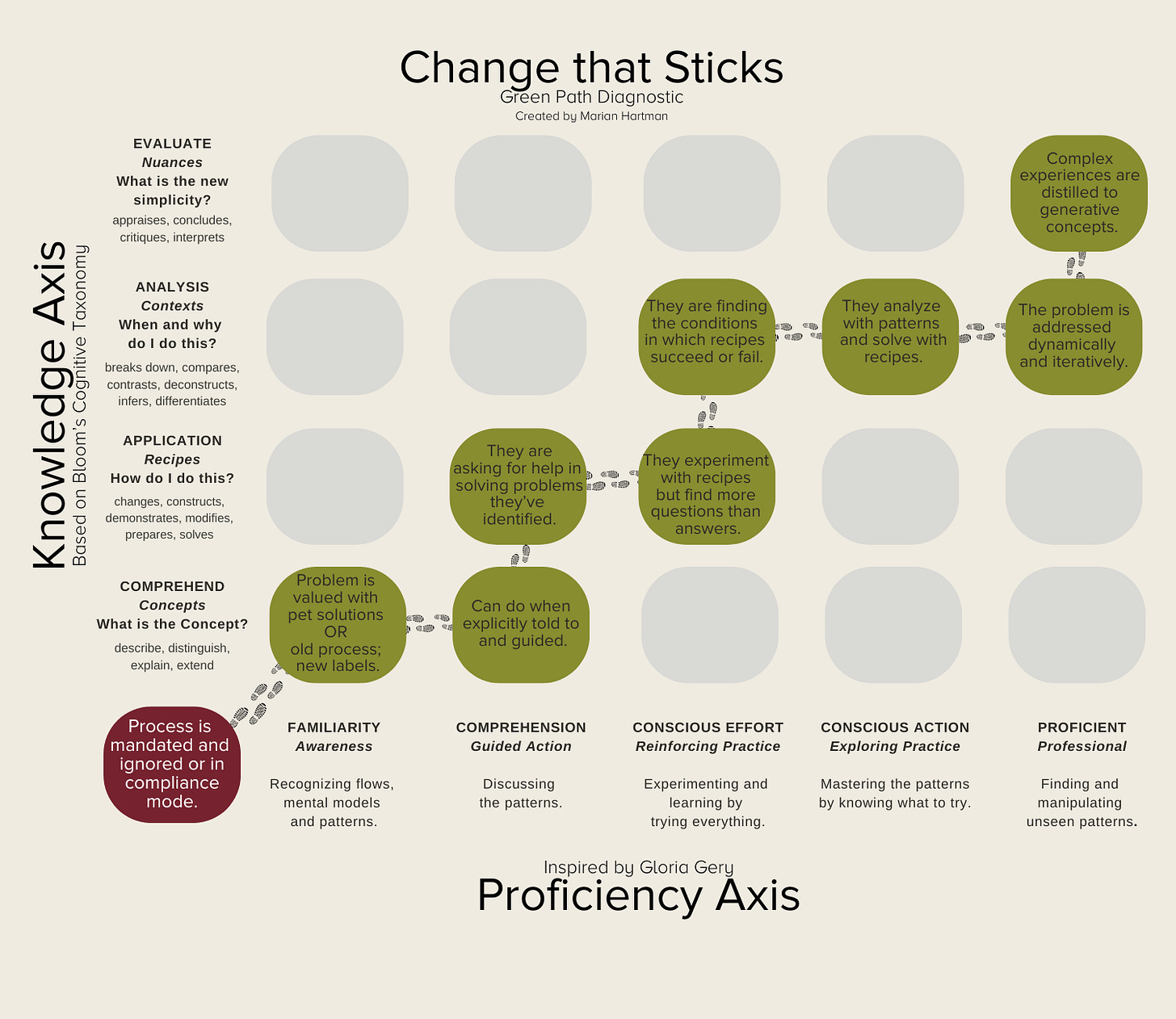We have valuable information that would make people sleep better at night and systems function more reliably. Yet, people aren’t sleeping better at night and systems continue to blow up. Last week I showed a model that helps us change behavior, not just spread information around.
When people ask me for help making change stick, the most common problem I see is a mis-identification of which block their people are actually in. Usually my clients think that they are much farther to the right on the green path than reality. So they take actions that don’t help their people change.
Often, they are not even on the chart yet, and stuck in this mode:
To help my clients make change stick, I help them understand where they are are in their information spread. This can be done with a mindfully applied diagnostic.
Green Path Diagnostic
Let’s Break it Down
Off the path:
The organization has developed a belief that people only change with a forcing function. Therefore, each change is rolled out with some mandate or tooling change that will force people to shift their behavior. People either ignore the mandate or comply.
Green Block 1:
We see a very unsophisticated but energetic response. Each team is coming up with solutions that are contextually useful from their perspective, but not necessarily systemically because their knowledge sophistication is still quite low.
Another possible response is that they will map what they have been doing onto the new picture. Same behavior; new labels. Please note that this is often done with integrity. There isn’t a subversion or resistance, they just don’t have enough practice to recognize how the desired behaviors are different from the old behaviors.
Green Block 2:
At this point the team can perform the new behavior, but only when an expert guides them through it. The knowledge sophistication has not changed. We are simply right-shifting along the proficiency axis. However open and motivated a team is, they are completely reliant on the coach’s next steps.
A big factor that separates Green Block’s 2 and 3 is knowledge sophistication. In Green Block 2, the team does not know what to ask, but are gaining in exposure and grounded experience in the new behavior.
Green Block 3:
Now that the knowledge sophistication has increased, likely due to the assistance of expertise combined with their grounded practice, they have transitioned from complete reliance to asking for assistance in identified areas. This is a signal that they are connecting the dots.
When they ask a coach for a set of instructions to apply, which I refer to as recipes, they will apply those in that specific circumstance, and then come back again if the circumstances change at all.
Green Block 4:
Over time, the people gain grounded practice with a bunch of different recipes. Now they stop asking for new instructions for each new situation, and instead try to adapt one of the recipes they already have. This results in more questions than answers.
It’s important to realize errors and frustration are at their highest points during Green Block 4.
Timing for the coach is critical here as the transition between blocks 4 and 5 is when the team is considering whether to adopt or abandon the behavior. Knowledge sophistication needs to up-shift to accommodate the grounded experience in which the team is floundering.
Green Block 5:
As frustration and disillusionment mount, the team stops assuming things will work and starts asking when will the new practice work, and why. You’ll hear far more contextual information in the questions from these teams. For example, they’ll start asking “I’m trying to X, so we tried Y, and it didn’t work because of Z. Why, and how do we do Y when Z is happening?”
Once the team has settled firmly into block 5, and understands cases when to apply the new practice and when not to, they are likely to continue following the path.
At block 5, teams are practicing the new techniques for everything and trying to see what works.
Green Block 6:
In Block 6, teams start to think about problems in terms of patterns, and solutions in terms of recipes. The right-shift from conscious effort (reinforcing practice) to conscious action (exploring practice) is visible by how teams engage with other teams. Teams in Block 5 listen to a question and offer a recipe. Any team asking a Block 6 team for help will get contextual questions followed by a recipe to follow.
Green Block 7:
This team doesn’t simply execute a plan. They dynamically observe data and behavior, adjusting based on that from moment to moment. They apply patterns in both problems and solutions. Each partial exploration causes them to adapt their understanding and follow different patterns.
Green Block 8:
It’s getting rarer and rarer to see a teams go from block to block as you move right. Progress tend to shift towards individual people, although there is the occasional team that makes the leap. However, Green Block 8 is certainly seen in the Thought Leader, where complexity gets distilled to a slogan, concept, or framework.
My focus is designing change in ways that make it stick, and diagnostics like this help us get started with the very first step — finding out the reality of where you’re at.
Find out more about tools like this in my webinar!




